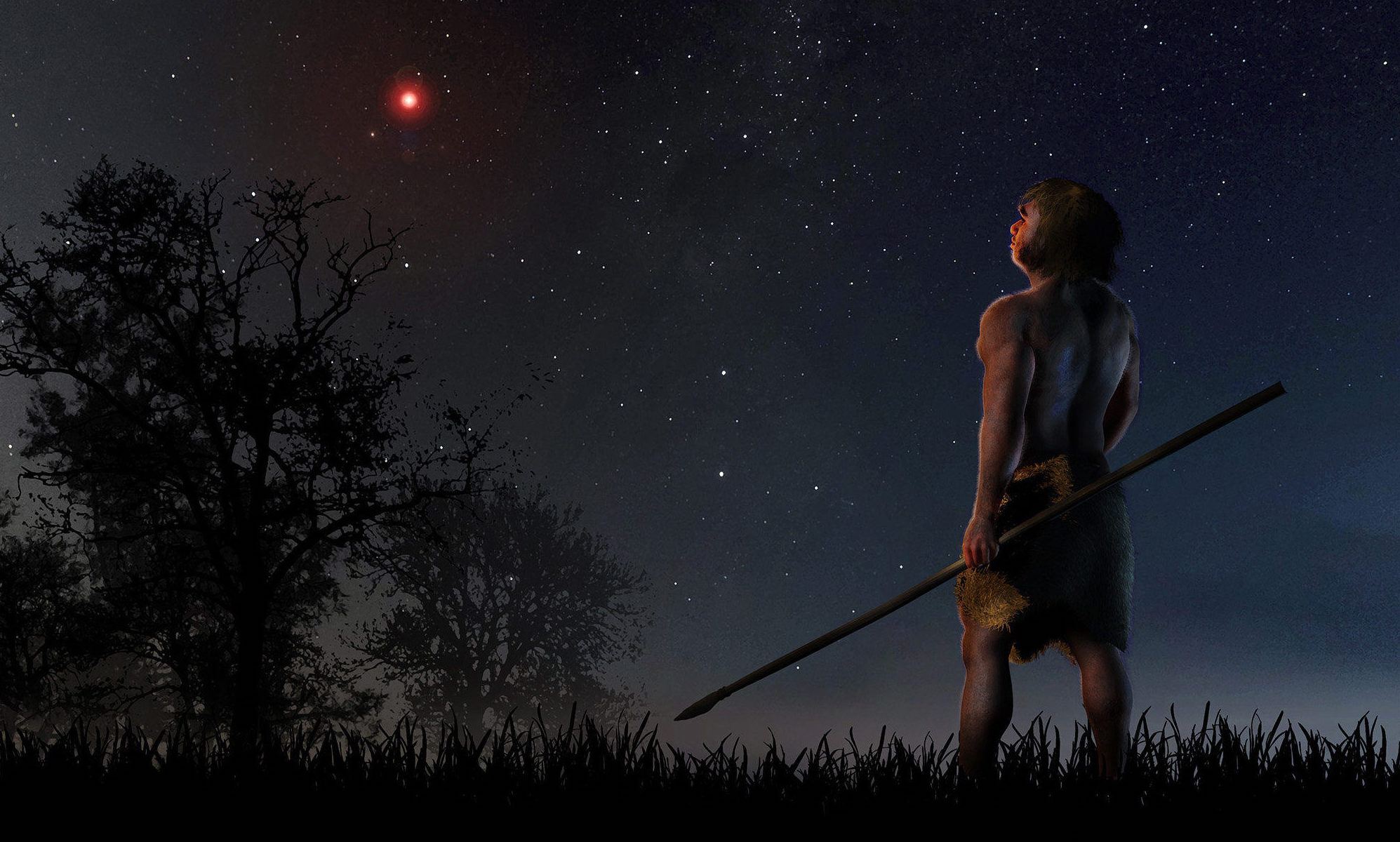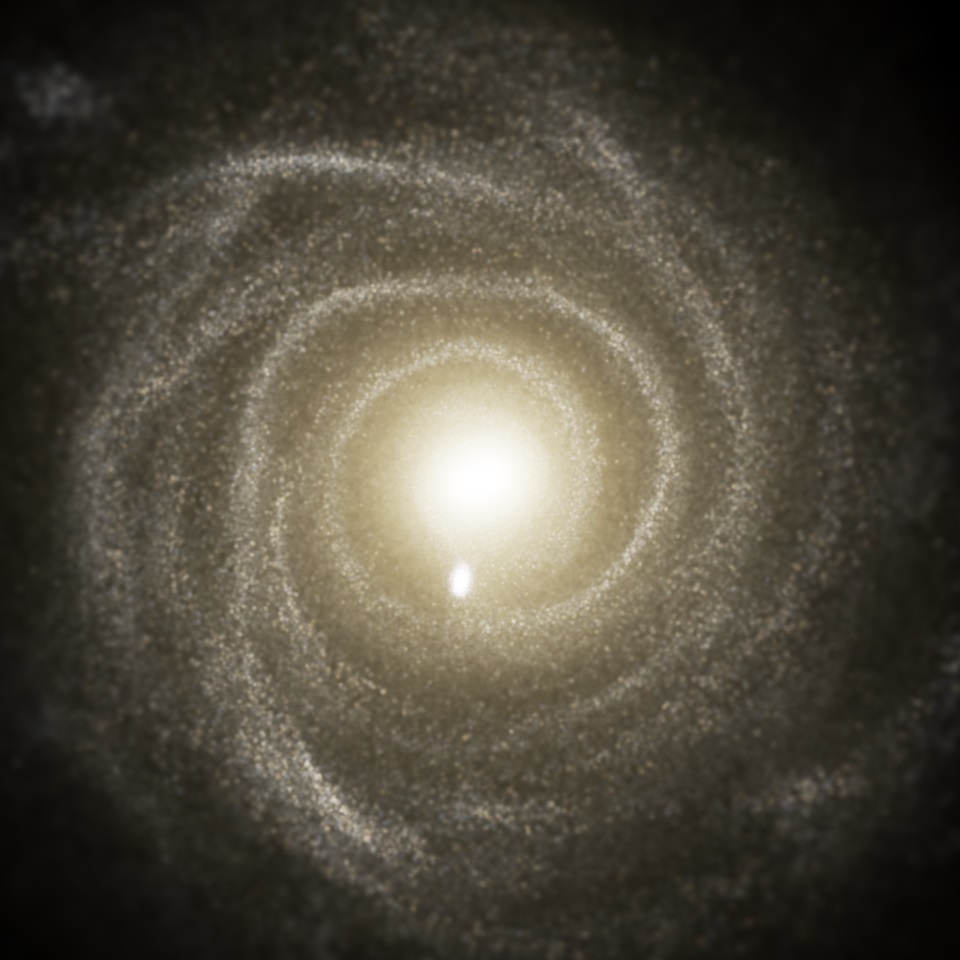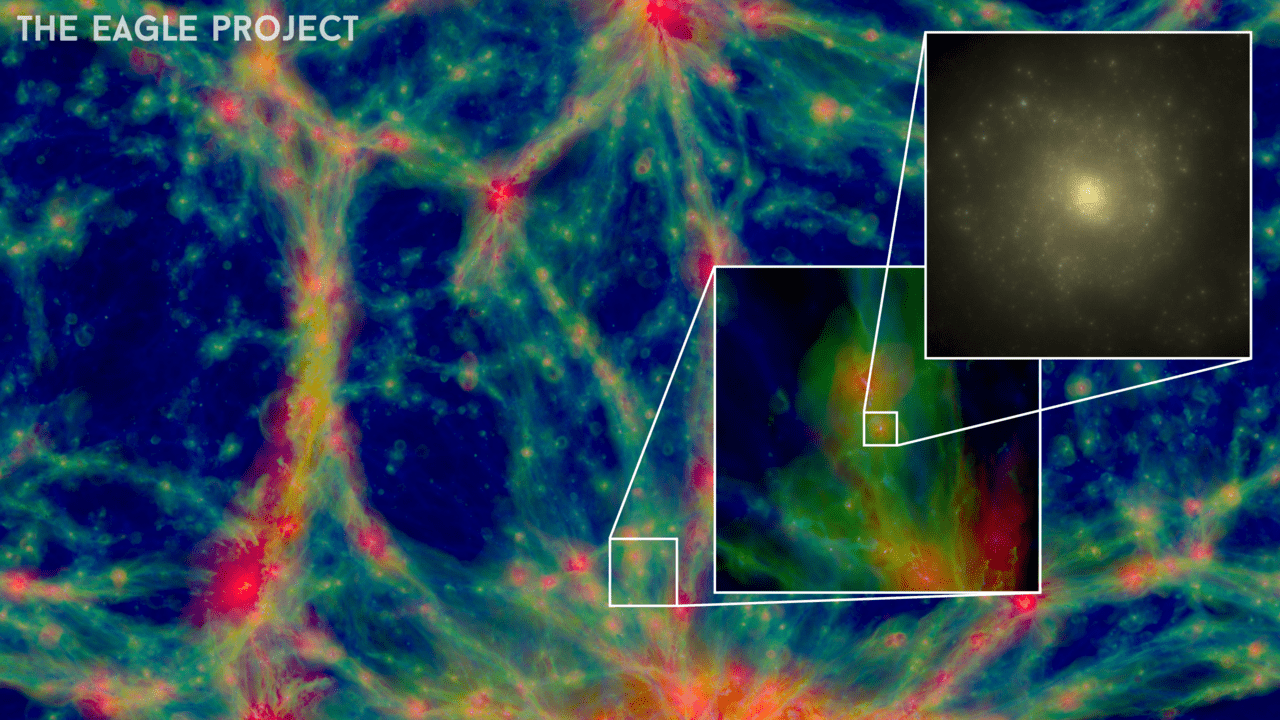The orbit of Earth around the Sun is always changing. It doesn’t change significantly from year to year, but over time the gravitational tugs of the Moon and other planets cause Earth’s orbit to vary. This migration affects Earth’s climate. For example, the gradual shift of Earth’s orbit and the changing tilt of Earth’s axis leads to the Milankovitch climate cycles. So if you want to understand paleoclimate or the shift of Earth’s climate across geologic time, it helps to know what Earth’s orbit was in the distant past.
Continue reading “Passing Stars Changed the Orbits of Planets in the Solar System”Galactic Panspermia. How far Could Life Spread Naturally in a Galaxy Like the Milky Way?
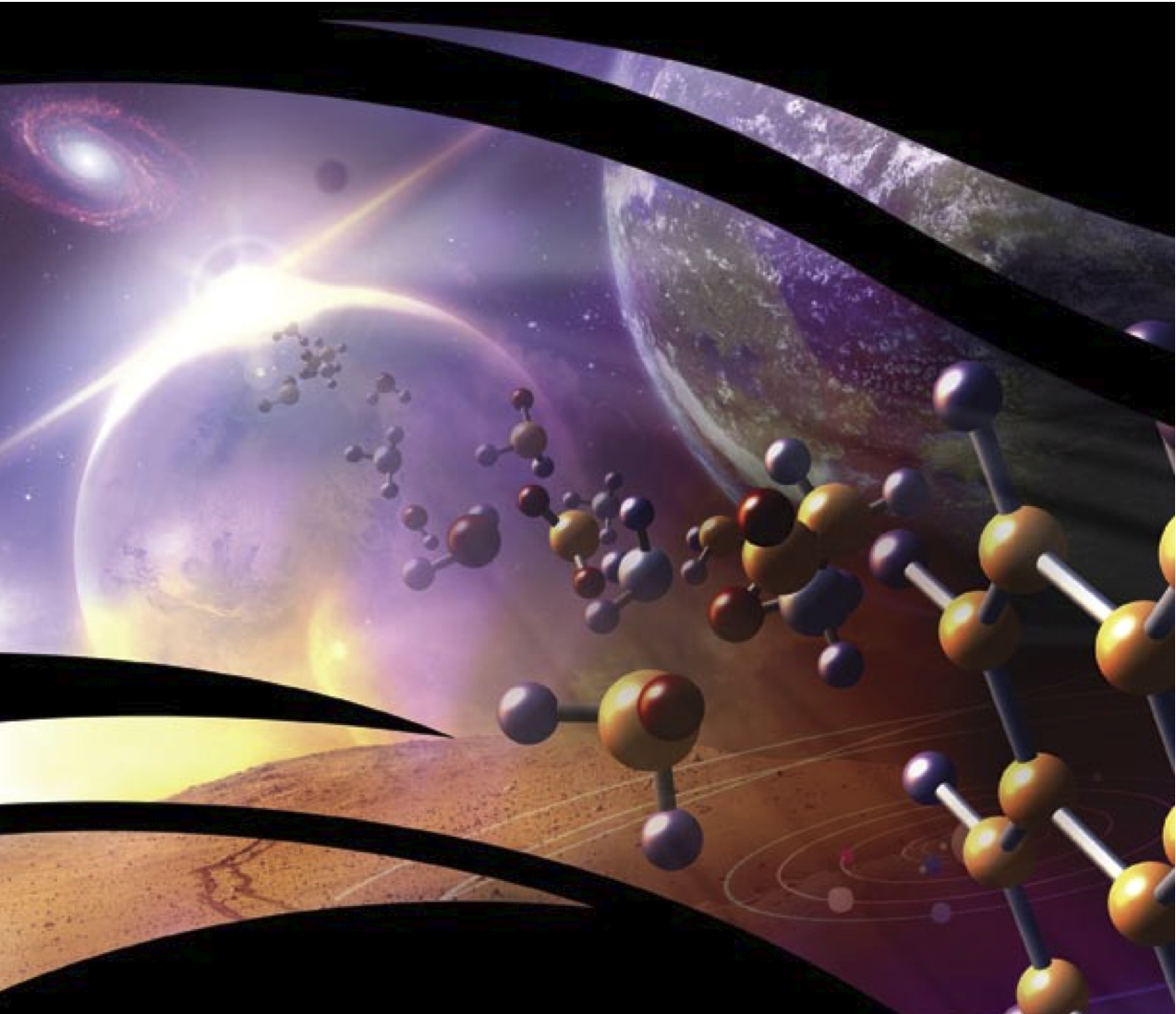
Can life spread throughout a galaxy like the Milky Way without technological intervention? That question is largely unanswered. A new study is taking a swing at that question by using a simulated galaxy that’s similar to the Milky Way. Then they investigated that model to see how organic compounds might move between its star systems.
Continue reading “Galactic Panspermia. How far Could Life Spread Naturally in a Galaxy Like the Milky Way?”Watch a Simulation of a Galaxy, From the Big Bang Until the Present Day
Since the mid-20th century, scientists have had a pretty good idea of how the Universe came to be. Cosmic expansion and the discovery of the Cosmic Microwave Background (CMB) lent credibility to the Big Bang Theory, and the accelerating rate of expansion led to theories about Dark Energy. Still, there is much about the early Universe that scientists still don’t know, which requires that they rely on simulations on cosmic evolution.
This has traditionally posed a bit of a problem since the limitations of computing meant that simulation could either be large scale or detailed, but not both. However, a team of scientists from Germany and the United States recently completed the most detailed large-scale simulation to date. Known as TNG50, this state-of-the-art simulation will allow researchers to study how the cosmos evolved in both detail and a large scale.
Continue reading “Watch a Simulation of a Galaxy, From the Big Bang Until the Present Day”New Simulation Models Galaxies Like Never Before
Astronomy is, by definition, intangible. Traditional laboratory-style experiments that utilize variables and control groups are of little use to the scientists who spend their careers analyzing the intricacies our Universe. Instead, astronomers rely on simulations – robust, mathematically-driven facsimiles of the cosmos – to investigate the long-term evolution of objects like stars, black holes, and galaxies. Now, a team of European researchers has broken new ground with their development of the EAGLE project: a simulation that, due to its high level of agreement between theory and observation, can be used to probe the earliest epochs of galaxy formation, over 13 billion years ago.
The EAGLE project, which stands for Evolution and Assembly of GaLaxies and their Environments, owes much of its increased accuracy to the better modeling of galactic winds. Galactic winds are powerful streams of charged particles that “blow” out of galaxies as a result of high-energy processes like star formation, supernova explosions, and the regurgitation of material by active galactic nuclei (the supermassive black holes that lie at the heart of most galaxies). These mighty winds tend to carry gas and dust out of the galaxy, leaving less material for continued star formation and overall growth.
Previous simulations were problematic for researchers because they produced galaxies that were far older and more massive than those that astronomers see today; however, EAGLE’s simulation of strong galactic winds fixes these anomalies. By accounting for characteristic, high-speed ejections of gas and dust over time, researchers found that younger and lighter galaxies naturally emerged.
After running the simulation on two European supercomputers, the Cosmology Machine at Durham University in England and Curie in France, the researchers concluded that the EAGLE project was a success. Indeed, the galaxies produced by EAGLE look just like those that astronomers expect to see when they look to the night sky. Richard Bower, a member of the team from Durham, raved, “The universe generated by the computer is just like the real thing. There are galaxies everywhere, with all the shapes, sizes and colours I’ve seen with the world’s largest telescopes. It is incredible.”
The upshots of this new work are not limited to scientists alone; you, too, can explore the Universe with EAGLE by downloading the team’s Cosmic Universe app. Videos of the EAGLE project’s simulations are also available on the team’s website.
A paper detailing the team’s work is published in the January 1 issue of Monthly Notices of the Royal Astronomical Society. A preprint of the results is available on the ArXiv.
Astrophotographers Capture Dramatic Photos of Comet Siding Spring Approaching Mars
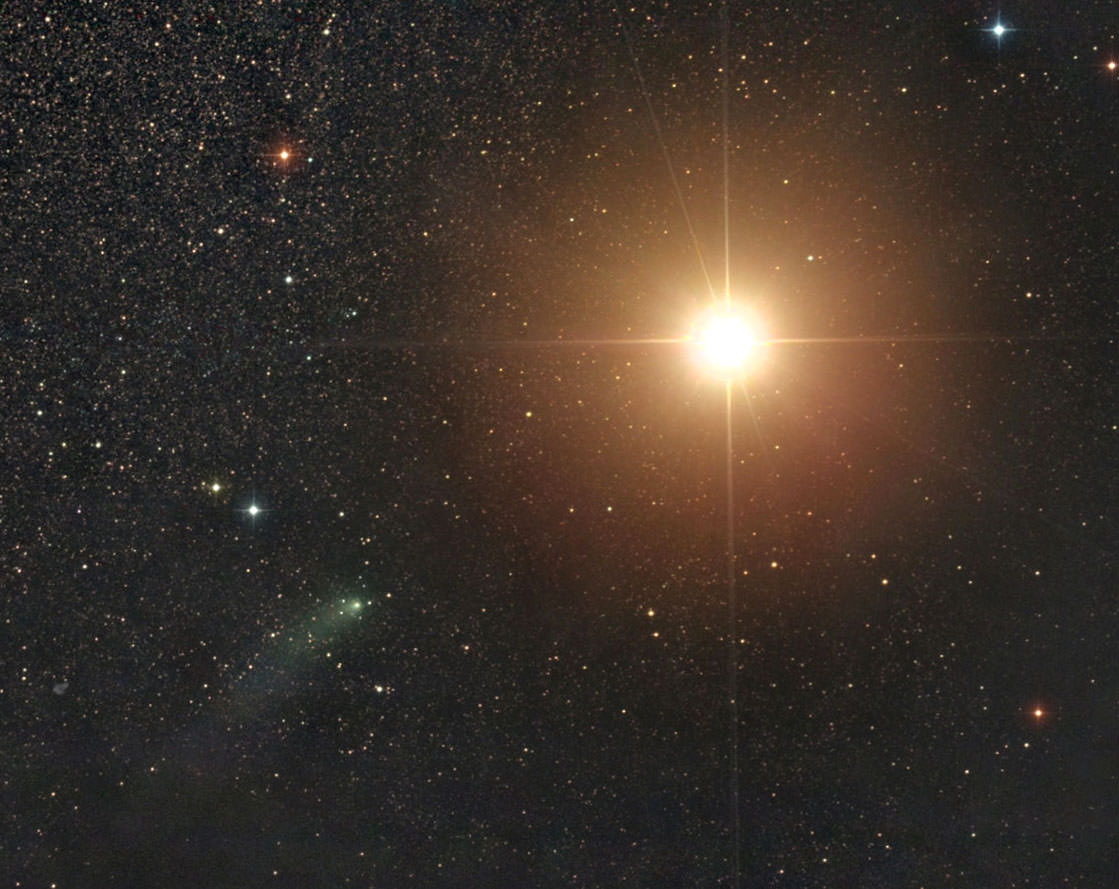
Astrophotographer Damian Peach shares this spectacular image of comet C/2013 A1 Siding Spring approaching Mars taken just hours ago. The faint comet shows a small, condensed coma and bent tail against the glaring orange glow of the brilliant planet. Most photos of comets passing by a planet or deep sky object are lucky line-of-sight pairings with the comet in the foreground and object light years away in the background. Not this one. Both Siding Spring and Mars lie at nearly the identical distance from Earth of 151 million miles (243 million km).
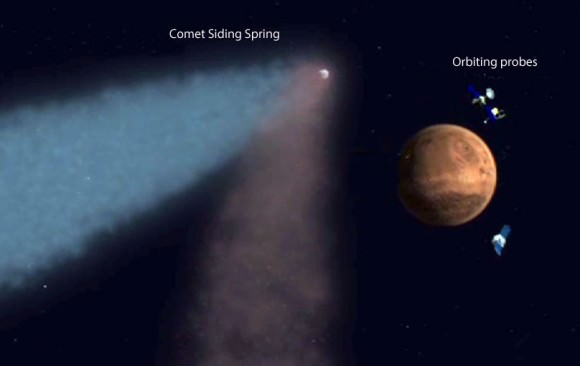
When closest to Mars this afternoon, Siding Spring is expected to shine at around magnitude -5 or about twice as bright as Venus. Mind you, that estimate considers the entire comet crunched down into a dot. But for those who remember, Comet Hale-Bopp remained at zero magnitude, 100 times fainter than Siding Spring, and made for one of the most impressive naked eye sights on spring evenings in 1997.
More recently, Comet McNaught climaxed at magnitude -5 in the daytime sky near the Sun in January 2007. It was plainly visible in binoculars and telescopes in a blue sky if you knew exactly where to look and took care to avoid the Sun. Would-be Martians are far more fortunate, with Siding Spring appearing high overhead in a dark sky from some locations, including that of NASA’s Curiosity Rover.
Comet C/2013 Siding Spring as it rises and sets over the Curiosity Rover this weekend October 18-19. Credit: Solarsystemscope.com
Right on time for today’s encounter, the folks at Solarsystemscope.com have rolled out an interactive simulation of Comet Siding Spring’s appearance in the sky above Curiosity. Just click the play button on the control panel above to run it live. Seen from Mars, the comet bobs along Eridanus the River southwest of Orion, passing high in the southern sky overnight. What a sight!
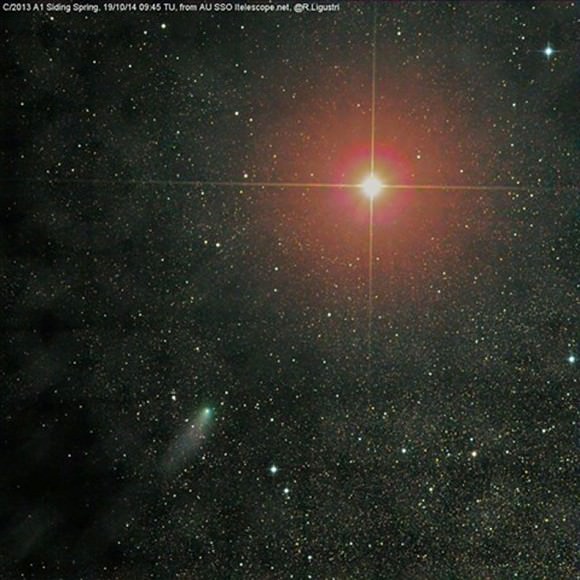
The comet nucleus is only about 0.4 miles (700 meters) across, but the coma or atmosphere fluffs out to around 12,000 miles (19,300 km). Seen from the ground, Siding Spring would span about 8°of sky or 16 full Moons from head to tail. Moving at 1.5° per minute, we could watch crawl across the heavens in real time with the naked eye. Wish I zoom to Mars for a look, but the rovers and orbiters will be our eyes as they study and photograph the comet during its brief flyby. As soon as those pictures become available, we’ll publish them here. Can’t wait!
Come Siding Spring comes out the other side!
While we’re waiting, amateur astronomers have been busy shooting additional photos and creating videos from their images. Fritz Helmut Hemmerich made this video from 1200-meters at Tenerife in the Canary Islands showing Comet Siding Spring immediately after its Mars encounter. One thing we know for certain is that the comet is intact after its close brush.

And find our more amazing photos and information at Sen TV, and you can follow them on Twitter at @sen.
How Watching 13 Billion Years Of Cosmic Growth Links To Storytelling

How do you show off 13 billion years of cosmic growth? One way that astronomers can figure that out is through visualizations — such as this one from the Harvard-Smithsonian Center for Astrophysics, called Illustris.
Billed as the most detailed computer simulation ever of the universe (done on a fast supercomputer), you can slowly see how galaxies come alight and the structure of the universe grows. While the pictures are pretty to look at, the Kavli Foundation also argues this is good for science.
In a recent roundtable discussion, the foundation polled experts to talk about the simulation (and in particular how the gas evolves), and how watching these interaction play out before their eyes helps them come to new understandings. But like any dataset, part of the understanding comes from knowing what to focus on and why.
“I think we should look at visualization like mapmakers look at map making. A good mapmaker will be deliberate in what gets included in the map, but also in what gets left out,” said Stuart Levy, a research programmer at the National Center for Supercomputing Applications’ advanced visualization lab, in a statement.
“Visualizers think about their audience … and the specific story they want to tell. And so even with the same audience in mind, you might set up the visualization very differently to tell different stories. For example, for one story you might want to show only what it’s possible for the human eye to see, and in others you might want to show the presence of something that wouldn’t be visible in any sort of radiation at all. That can help to get a point across.”
You can read the whole discussion at this webpage.
Watch Live As Underwater Astronauts Drill Into The Ocean Floor
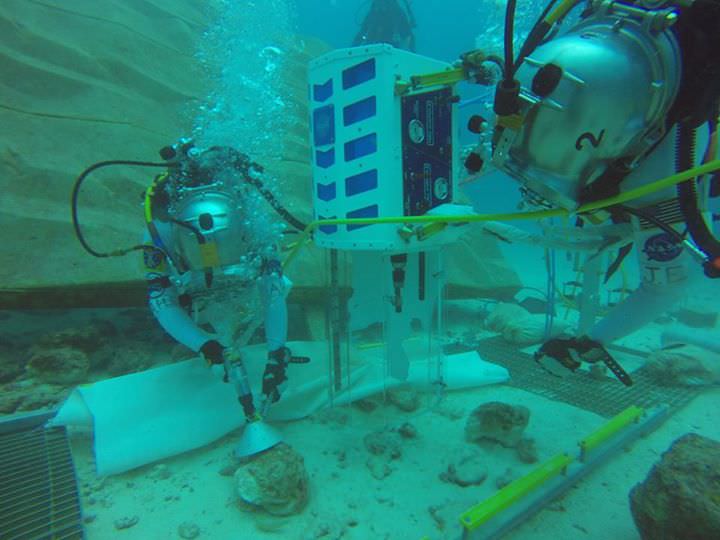
How do we send humans to asteroids or Mars? While the answer is complex, one part of it is to say “a simulation mission at a time.” That’s one of the roles of the NASA Extreme Environment Mission Operations (NEEMO) project, which now is seeing its 18th crew temporarily live in a habitat 62 feet beneath the Atlantic Ocean’s waves.
Astronauts spend time in the small Aquarius habitat and every so often, venture outside — including right now that goes until about 1 p.m. EDT (5 p.m. UTC). Luckily for us virtual aquanauts, there are six possible livestreams to choose from — so have fun figuring out which is the best view! You can catch all the action at this web page.
And if you miss today’s, another one is scheduled for tomorrow around 9:30 a.m. to 12:30 p.m. EDT (1:30 p.m. to 5:30 p.m. UTC).
The NEEMO 18 crew includes Astronaut Akihiko Hoshide of the Japan Aerospace Exploration Agency (JAXA), NASA astronauts Jeanette Epps and Mark Vande Hei, and European Space Agency (ESA) astronaut Thomas Pesquet.
“Today, during EVA tasks, Aki and Jeanette will deploy the boom, set up the core drill, and use it to collect samples from the ocean floor,” the NEEMO Facebook page stated.
Learn more about the mission on the NEEMO website.
Watch a Million Particles Collide
What happens when you give 1,000,000 particles their own gravity and spring repulsion and send them out to play? Watch the video above and find out.
This was created by David Moore, a self-taught computer programmer, aspiring physicist and student at San Diego Miramar College. It’s a custom code made with SDL/C++ and 8 days of render time. According to David there’s a bug at the end “where particles can get arbitrarily high energy… but before that it’s very physically accurate!”
It’s fascinating to watch the attraction process take place — one might envision a similar process occurring in the early Universe with the formation of the first galaxies and galactic clusters out of a hot, uniform state. Plus it’s great to see young talented minds like David’s working on such projects for fun!
There just might be hope for us after all.
Video by David Moore

